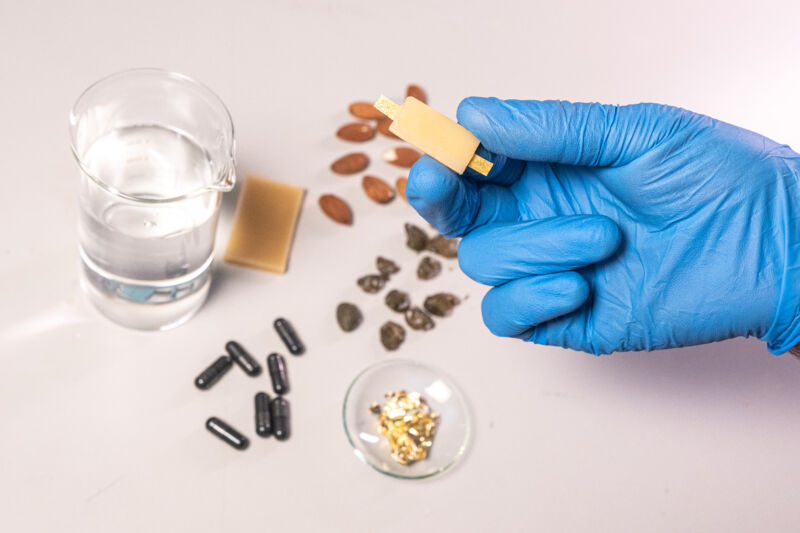Researchers craft a fully edible battery

Can you tell me how many batteries you use in a year? A report from the University of Illinois reveals that Americans buy about 3 billion dry-cell batteries annually, which means that an average American ends up using nearly 10 batteries a year. Of course, this shouldn’t come as a surprise given that almost everything we use runs on batteries. What’s shocking is that out of these billions of batteries, about 2,500 end up in the stomachs of kids.
Almost every day, there are numerous cases of kids swallowing batteries that power their toys, watches, or gadgets; this results in many cases of internal injuries or stomach infections.
A team of researchers at the Italian Institute of Technology (IIT) in Milan recently created a fully rechargeable battery using nontoxic edible components. This is probably the world’s first battery that is safe to ingest and entirely made of food-grade materials. “Given the level of safety of these batteries, they could be used in children’s toys, where there is a high risk of ingestion,” said Mario Caironi, a senior researcher at IIT. However, this isn’t the only solution the edible battery could provide.
Edible battery solves many problems
Apart from serving as an alternative to conventional toxic toy batteries, the edible battery from IIT could also play a key role in making health care applications safer than ever. For instance, doctors have to be cautious regarding the use of miniature electronic devices (such as drug-delivery robots, biosensors, etc.) inside the human body, as they come equipped with batteries made of toxic substances. An edible battery could solve this problem. There are also more mundane applications, like replacing batteries in pet toys.
Ivan K. Ilic, first author of the study and a postdoctoral researcher at IIT, told Ars Technica, “Two main ways a battery damages human tissue when it’s inside the body is by doing water electrolysis and by the toxicity of its materials. Water electrolysis is a phenomenon where electricity with a voltage higher than 1.2 V (virtually all commercial batteries) breaks water into oxygen and hydrogen (an explosive gas), and it is very dangerous if it occurs in the stomach. Our battery is way below this voltage, around 0.65 V, so water electrolysis cannot occur. On the other hand, we used only food materials, so nothing is toxic!”
Before the battery is useful, however, the researchers will need to first enhance the battery’s power capacity. Currently, the edible battery can supply 48 microamperes of current for a bit over 10 minutes. So it can easily meet the power demand of a miniature medical device or a small LED. “These batteries are no competition to ordinary batteries—they will not power electric cars—but they are meant to power edible electronics and maybe some other niche applications, so their main advantage is non-toxicity,” said Ilic.
What makes the edible battery work?
Surprisingly, the researchers were able to find a suitable edible material for every single component necessary for building a working edible battery. The best part is that battery manufacturers won’t have to mine anything because edible batteries can be made using ingredients typically found in a grocery store. Here is a list of everything that makes the battery work:
- Quercetin, a pigment found in almonds and capers, serves as the battery cathode, whereas riboflavin (vitamin B2) makes up the battery anode.
- The researchers used nori (edible seaweed that is used in the wrapping of sushi rolls) as the separator and a water-based solution (aqueous NaHSO4) as the electrolyte.
- Activated charcoal is employed to achieve high electrical conductivity in the battery.
- The battery electrodes come covered in beeswax and connect to a gold foil (used to cover pastries) that laminates a supporting structure made of ethyl cellulose.
While explaining the energy flow in the setup, Ilic told Ars, “During charging the electrons migrate from quercetin to riboflavin. When we use the battery, the opposite occurs. Therefore we can power devices. Indeed, our innovation is scalable, and if you want to double the energy of the battery, you just need to double the surface of the electrodes!”
While all of these components are nontoxic and edible, the researchers clarify that a user is not supposed to eat the battery on purpose, which would obviate the whole point of making it rechargeable. The main purpose of this innovation is to promote the use of safer, more sustainable, and toxin-free energy storage solutions.
The IIT team is currently developing various edible electronic elements, including transistors. The researchers hope that once they crack the formula for edible transistors, they can build edible logic devices and power them with the battery. They also plan to develop the first fully edible electronic devices with specific functions, such as monitoring pH in the stomach and, eventually, more complex tasks.
Advanced Materials, 2023. DOI: 10.1002/adma.202211400 (About DOIs)
Rupendra Brahambhatt is an experienced journalist and filmmaker. He covers science and culture news, and for the last five years, he has been actively working with some of the most innovative news agencies, magazines, and media brands operating in different parts of the globe.
https://arstechnica.com/?p=1937723